More AIS in the USA, the new USCG requirements
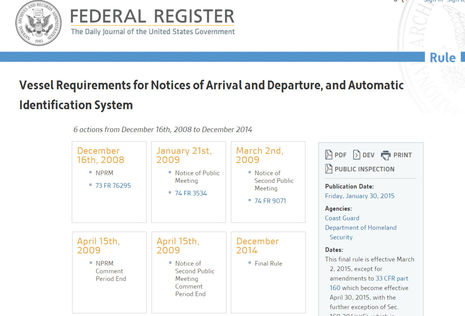 Please credit the U.S. Coast Guard with a sense of humor. The (NOA and) AIS Final Rule may be a dry read, but not last week's email announcement, which began with the giddy declaration "4,232 days in the making!" I don't know why the rulemaking process took so long, and it may have been most frustrating for those who do, but I'll still be glad to have more of the commercial vessels working along our coasts equipped with AIS. It won't happen fast, though -- vessels newly required to carry Class A or B AIS transponders can take until March 2016 to install them -- and the number of such vessels seems uncertain...
Please credit the U.S. Coast Guard with a sense of humor. The (NOA and) AIS Final Rule may be a dry read, but not last week's email announcement, which began with the giddy declaration "4,232 days in the making!" I don't know why the rulemaking process took so long, and it may have been most frustrating for those who do, but I'll still be glad to have more of the commercial vessels working along our coasts equipped with AIS. It won't happen fast, though -- vessels newly required to carry Class A or B AIS transponders can take until March 2016 to install them -- and the number of such vessels seems uncertain...
When the new requirements were first drafted in 2008, the USCG suggested that Class B transponders might be allowed in some cases to lower costs. In fact, about half of the commercial vessels affected by the requirements will be allowed to use Class B, as illustrated above and at Vesper Marine. Vessels less than 65' but with 50 or more passengers escaped AIS requirements in the final rule, but when I wrote "USCG AIS mandates, get'er done, please!" in 2010 they only accounted for about 1,000 boats and all the USCG category counts have gone down considerably.
The CG has posted the new "Potentially Effected Population" (sic) count above on their informative AIS FAQ list. Compared to the 2010 count, the total fishing vessels over 65 feet went from over 5,500 to under 3,000, and towing vessels > 26' & > 600hp from over 4,500 to under 1,500. With the <65' >50 passenger exclusion, the grand total went from over 17,000 to 5,848. I thought the lower category numbers might be because they eliminated vessels that had already installed AIS voluntarily -- like the Maine State Ferries (thank goodness) -- but actually it's because the CG "rid our databases of old and/or duplicate records."
So I'm going to guess (wildly) that the number of vessels which haven't already installed AIS but must by 3/1/2016 is about 4,000. That's a long way from 17,000, but then again, many of the new AIS vessels are underway a lot, voluntary Class B on recreational vessels is increasing rapidly, and the more boats that have it, the more useful it is. It's a virtuous circle.
If you do have a commercial vessel that may be affected by the new requirements -- or if you install electronics on such vessels -- perhaps the best breakdown of the "A or B" question is the one above created by SRT and posted at Port Supply along with some good videos about installing (SRT made) Em-Trak Class A and B devices on workboats. Milltech Marine is a great AIS resource, especially for do-it-yourselfers; the expertise of True Heading has come to the USA; and there are reviews and more in Panbo's AIS section. Now let's look beyond extended AIS carriage requirements in the USA.
We added a section to 33 CFR part 62 and amended two sections in part 66 to address a comment requesting that we expand AIS carriage to offshore fixed structures. In our NPRM, we encouraged broader use of AIS, but this comment highlighted a particular shortcoming regarding offshore fixed structures. Our proposed rule addressed mobile shipboard devices such as AIS Class A or B, but not offshore structures or AIS Aids to Navigation (AIS AtoN) systems which are best suited for fixed position deployment, such as on offshore oil platforms. Existing AtoN regulations (see 33 CFR 66.01-1 Basic Provisions) bar the use of AIS as a Private Aid to Navigation, and thus preclude the use of an AIS AtoN on certain fixed structures. This prohibition in the current AtoN regulations is inconsistent with our stated objective of broadening the use of AIS. An AIS AtoN would provide position, name, and health status of the aid, such as "on station, watching properly." These amendments to parts 62 and 66, which allow for enhanced MDA and improved navigation safety, would not require anyone subject to our rule to establish an AIS AtoN, they would merely make that option available.
There's a whole lot more to the new regulations, and I don't mean the Notice of Arrivals (NOA) part, which I don't fully understand and which doesn't seem relevant to recreational vessels. What struck me in the long, though often elegantly written, Final Rule is the Coast Guard's broad confidence in the value of AIS both for vessel safety and MDA (Marine Domain Awareness), plus its longterm vision for using it for even more good. I hope the folks who worry about AIS "clutter" and an overburdened system pay attention to where the experts are at after years of experiencing AIS in action.
One example is a modification to the AtoN regs that permits AIS AtoNs -- now in wide beta use around the U.S.-- to be put up privately (with permission). I highlighted the pertinent Final Rule text above, but then check out the actual "Broader Use of AIS" section for a description of how AIS Application Specific Messaging (ASM) will be used to "provide a more dynamic detail to information that is traditionally conveyed by slower means: chart updates, (e.g., new navigation hazards), printed notices to mariners, navigation publications and directives, meteorological and hydrographic Web sites, and more." I'm just beginning to understand the ASM aspect of AIS myself, but the USCG is on it, and the possibilities are exciting.
Of course, other people may read this rule in other ways (which may be why it took so long to iron out). In fact, I've already heard from a chap who wrote of the rule that he was "surprised that the recreational 65' vessel was dropped as it was a concern for homeland security and the potential carrying capacity for destructive weapons." When I replied that I'd never had an inkling that the USCG was planning to mandate AIS on recreational vessels, he couldn't document his assertion at all, but nonetheless referenced the Rule Note at bottom to conclude that:
Captain of the Port now has the very broad authority to determine who may be required to install AIS...which is a round-about method to addressing to any recreation vessels. You will note it does not specify commercial. This presently satisfies the Homeland security issue and would allow a "quick" fix if desired. (Anticipate the future to require recreational vessels over 65' to be AIS carriage in certain areas.)
Sheesh! What the Note actually says, I'm pretty sure, is that while the Captain of the Port has always had broad authority to restrict vessel use, he or she can now permit a dubious vessel of any sort to operate if it voluntarily installs AIS. It's an option, not a mandate, even for those folks who think AIS somehow threatens their liberty. What concerns me much more is what happens if terrorists do strike a soft target with a small vessel, as I once heard a USCG Rear Admiral worry about. But that's me. What rational conclusions do you draw from the new regs, and what did you find if dug deep?

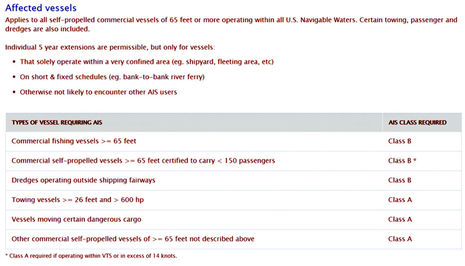
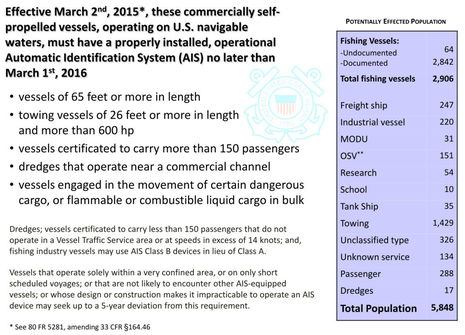
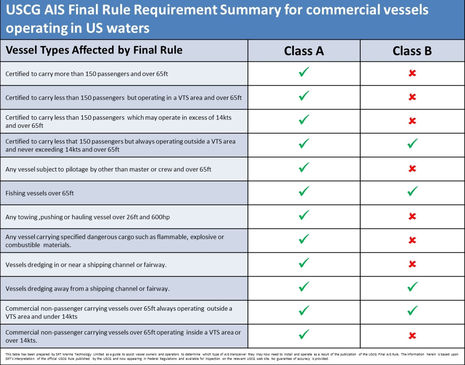
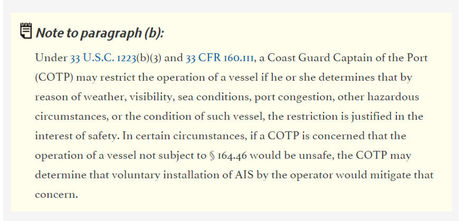
 Share
Share
I'm with you, Ben - the more vessels that have it, the better the system works.
I also think that the cost of these devices should also decrease as the population goes up, but perhaps there just aren't enough boats out there to make a real difference. For sure the technology will continue to progress, however, which should also tend to decrease cost (and size) as well as enhance the feature sets.
For example, I would love to have a low-power AIS to take on my kayak while poking around the bay - my wife could see where I was, and I would be less likely to be run over (kayaks ARE hard to see sometimes). I have an AIS emergency beacon now, but that's not the same thing.